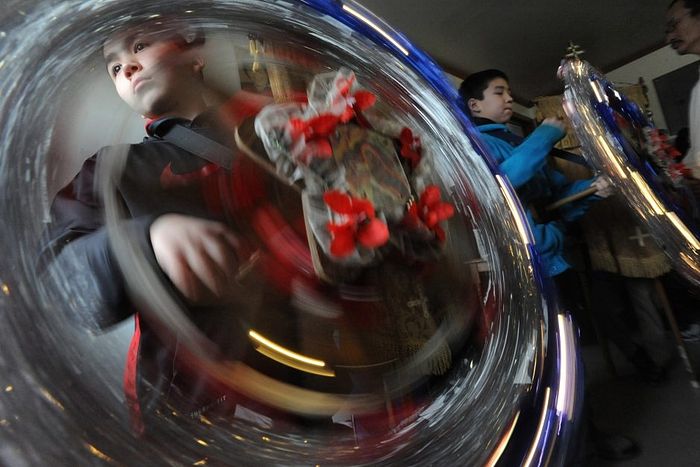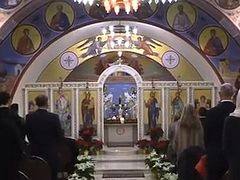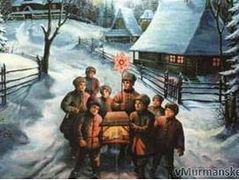Source: Alaska Dispatch News
January 16, 2016
 Stephen Maxie, III, left, and Dezmin Johnson, right, both 12, starring in the home of Father Vasily Fisher as parishioners celebrate the Orthodox Christmas on Wednesday, Jan. 7, 2015, in the Yup'ik village of Napaskiak, about 7 miles down river from Bethel along the Kuskokwim River.
Stephen Maxie, III, left, and Dezmin Johnson, right, both 12, starring in the home of Father Vasily Fisher as parishioners celebrate the Orthodox Christmas on Wednesday, Jan. 7, 2015, in the Yup'ik village of Napaskiak, about 7 miles down river from Bethel along the Kuskokwim River.
Last week I attended Orthodox services at St. Alexis Mission in celebration of Christmas. The Orthodox Church in America counts nearly 90 churches across Alaska, and congregations here, and in Canada and 14 other countries, celebrate Christmas on Jan. 7, a practice harkening back to the church’s beginnings. The church in these regions follows a modified Julian calendar. (Locally, Greek and Antiochian Orthodox celebrate the birth of Jesus on Dec. 25 using the Gregorian calendar for dating Christmas.)
In Alaska, Orthodox churches conduct Divine Liturgy services at 9 a.m. When a place of worship becomes too small, they do not add services but form a new body, i.e. mission, for the purpose of raising a new church. St. Alexis Mission meets at the Aleutian Pribilof Islands Association headquarters building on East International Airport Road. This temporary meeting space requires them to pack and store everything after services, no simple feat. Orthodox services involve the use of many icons and Eucharistic items which, in the temporary space, cannot be left in place.
The Very Rev. Jonah Andrew is assigned to the the mission, where he is sometimes assisted by the Very Rev. Michael Oleksa. Although Oleksa is retired, he is active in many other activities outside of St. Alexis. Andrew was in Tyonek celebrating Christmas at St. Nicholas Church, so Oleksa was the celebrant at both services I attended.
The 9 a.m. Christmas service at St. Alexis, a simple service including Eucharist, was led by Oleksa and a small choir. Orthodox services, except for the homily, are celebrated with the congregants standing. The service was very musical with the choir and the priest intertwining voices during the liturgy. Often, Oleksa raised his voice in support of the choir, even harmonizing with them.
In the Orthodox tradition, Christmas is preceded by 40 days of fasting -- no easy feat, considering the fast period starts before Thanksgiving, and runs through the New Year. The Christmas service was a standard liturgy with special introductory psalms. The Gospel was Matthew, the story of the Magi, and in his homily, Oleksa talked about the Magi, and the birth of Jesus, pointing to the Magi in the primary icon, which are depicted as if seen from afar to emphasize the length of their journey. After the Eucharist, St. Alexis’ star was twirled to the sound of liturgical hymns for this feast day. Several times Oleksa joyfully announced, “Christ is born!” To which all responded, “Glorify him!” After the service, all were invited to Oleksa’s house for more hymns, folk carols and breakfast.
Oleksa was the celebrant again when vespers was celebrated that evening at St. Alexis -- this time with fewer worshippers, and a much smaller choir. It was a beautiful service with another brief homily in which Oleksa depicted the Christian ending to one’s life; painless and blameless. Another “starring” was held. Not even the Protestant churches mark this time and event with such gusto.
After the service, Oleksa invited all present to meet up and join for “starring” and hymns at Lois and Tomislav Vasiljevic’s home in Russian Jack. Separately, Oleksa told me Tomislav, who is Serbian, was also celebrating his family Slava. “Serbian Orthodox are unique in that they do not celebrate their patron saint or Name Day, but instead celebrate the feast day on which their family became Christian,” Oleksa said. “In Tomislav’s case it was over 1,000 years ago that their whole village became Christian. St. Alexis always takes its star there, and sings for Tom and his family, who also treat us to a meal.”
Worshippers sang traditional Serbian religious music, while Oleksa’s son twirled the star. After the meal, Vasiljevic asked Oleksa to pray a healing prayer for him, which Oleksa did while placing a cross on him.
As I started writing this column, I had the impression most Orthodox worshippers avoid the temptation to succumb to the commercial trappings surrounding Christmas. However, the Rt. Rev. David Mahaffey, bishop of Sitka and Alaska, shared a strong statement of support for those who hold true to church recommendations saying, “I admire all those who wait until January 7 to celebrate the Nativity of Christ, because all the commercialism and busyness that has become the trappings of Christmas, has nothing to do with the birth of Christ, but more to do with the merchant’s pocketbook.”
“Alaska Missionary Spirituality,” a collection of 18th- and 19th-century letters, diaries and sermons of Orthodox missionaries in Alaska edited by Oleksa, explains starring as a “Native Alaskan term for traditional Julian calendar Christmas, combining elements of Ukrainian/Russian Orthodox hymns and folk customs and traditional indigenous practices. A pinwheel-shaped star, representing the Star of Bethlehem, with an icon of the Nativity of Christ in the center, leads the procession of carolers from house to house, where:
(1) In Aleut regions, they sing Orthodox and the traditional '“Many Years,' often greeted with a rifle salute.
(2) In some Yup’ik Eskimo regions, all are treated to a lavish three-course meal (with the elders and church functionaries dining first). And in some households adults are presented with small gifts.
(3) In other Yup’ik areas, each household presents 'to the Star' their major annual contribution to the parish that the singers represent.”
I enjoyed my warm, in-depth introduction to Orthodox Christmas.



